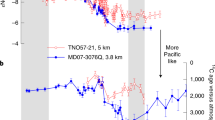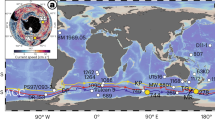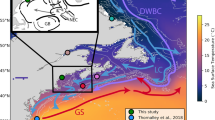Abstract
The mechanics of ocean circulation during the Late Cretaceous greenhouse interval remain contested1,2,3,4,5,6, with the role of North Atlantic Deep Water in ocean circulation particularly debated: the relative warming of the North Atlantic during the termination of the greenhouse interval has been attributed to heat piracy from North Atlantic Deep Water formation5,6, but the sources of Cretaceous deep water have been difficult to resolve. Nd isotopes as captured by seafloor sediments and expressed as ɛNd(t) reflect the region in which the water mass was formed. Here we present ɛNd(t) measurements from Cretaceous- to Palaeogene-aged sediments from four cores in the tropical North Atlantic. Before 69 Myr ago, we find extremely low ɛNd(t) values of about −16, consistent with the presence of a warm, saline deep water mass formed in the low latitudes7,8. By 62 Myr ago, ɛNd(t) values had risen to −11, similar to values reported from the northern North Atlantic over the past 65 million years, but lower than most contemporaneous values in the South Atlantic9 and Pacific oceans7,10. We therefore suggest that the ɛNd(t) shift reflects the increasing influence of a northern-sourced water mass at this site, indicating the onset or intensification of deep- or intermediate-water formation in the North Atlantic 69 Myr ago. Our findings support the heat piracy model and imply that circulation patterns during the greenhouse interval were different from those of the subsequent relatively temperate interval.
This is a preview of subscription content, access via your institution
Access options
Subscribe to this journal
Receive 12 print issues and online access
$259.00 per year
only $21.58 per issue
Buy this article
- Purchase on Springer Link
- Instant access to full article PDF
Prices may be subject to local taxes which are calculated during checkout



Similar content being viewed by others
References
MacLeod, K. G. & Hoppe, K. A. Evidence that inoceramid bivalves were benthic and harbored chemosynthetic symbionts. Geology 20, 117–120 (1992).
Frank, T. D. & Arthur, M. A. Tectonic forcings of Maastrichtian ocean-climate evolution. Paleoceanography 14, 103–117 (1999).
MacLeod, K. G. & Huber, B. T. in Western North Atlantic Palaeogene and Cretaceous Palaeoceanography, Special Paper Vol. 183 (eds Kroon, R., Norris, R. D. & Klaus, A.) 111–130 (Geological Society, 2001).
Abramovich, S., Yovel-Corem, S., Almogi-Labin, A. & Benjamini, C. Global climate change and planktic foraminiferal response in the Maastrichtian. Paleoceanography 25, PA2201 (2010).
Isaza-Londoño, C., MacLeod, K. G. & Huber, B. T. Maastrichtian North Atlantic warming, increasing stratification, and foraminiferal paleobiology at three timescales. Paleoceanography 21, PA1012 (2006).
MacLeod, K. G., Huber, B. T. & Isaza-Londoño, C. North Atlantic warming during global cooling at the end of the Cretaceous. Geology 33, 437–440 (2005).
MacLeod, K. G., Martin, E. E. & Blair, S. W. Nd isotopic excursion across Cretaceous ocean anoxic event 2 (Cenomanian–Turonian) in the tropical North Atlantic. Geology 36, 811–814 (2008).
Jiménez Berrocoso, Á. et al. Nutrient trap for Late Cretaceous organic-rich black shales in the tropical North Atlantic. Geology 38, 1111–1114 (2010).
Robinson, S. A., Murphy, D. P., Vance, D. & Thomas, D. J. Formation of ‘Southern Component Water’ in the late cretaceous: Evidence from Nd-isotopes. Geology 38, 871–874 (2010).
Frank, T. D. et al. The Maastrichtian record from Shatsky Rise (northwest Pacific): A tropical perspective on global ecological and oceanographic changes. Paleoceanography 20, PA1008 (2005).
Pucéat, E., Lécuyer, C. & Reisberg, L. Neodymium isotope evolution of NW Tethyan upper ocean waters throughout the Cretaceous. Earth Planet. Sci. Lett. 236, 705–720 (2005).
Frank, M. Radiogenic isotopes: Tracers of past ocean circulation and erosional input. Rev. Geophys. 40, 1-1–1-38 (2002).
Martin, E. E. & Scher, H. D. Preservation of seawater Sr and Nd isotopes in fossil fish teeth: Bad news and good news. Earth Planet. Sci. Lett. 220, 25–39 (2004).
Huber, B. T., MacLeod, K. G. & Tur, N. A. Chronostratigraphic framework for Upper Campanian–Maastrichtian sediments on the Blake Nose (Subtropical North Atlantic). J. Foraminiferal Res. 38, 162–182 (2008).
Abramovich, S. & Keller, G. High stress late Maastrichtian paleoenvironment: Inference from planktonic foraminifera in Tunisia. Palaeogeogr. Palaeoclimatol. Palaeoecol. 178, 145–164 (2002).
Clarke, L. J. & Jenkyns, H. C. New oxygen isotope evidence for long-term Cretaceous climatic change in the Southern Hemisphere. Geology 27, 699–702 (1999).
Huber, B. T., Norris, R. D. & MacLeod, K. G. Deep-sea paleotemperature record of extreme warmth during the Cretaceous. Geology 30, 123–126 (2002).
Friedrich, O., Erbacher, J., Moriya, K., Wilson, P. A. & Kuhnert, H. Warm saline intermediate waters in the Cretaceous tropical Atlantic ocean. Nature Geosci. 1, 453–457 (2008).
O’Nions, R. K., Frank, M., Von Blanckenburg, F. & Ling, H. F. Secular variation of Nd and Pb isotopes in ferromanganese crusts from the Atlantic, Indian and Pacific Oceans. Earth Planet. Sci. Lett. 155, 15–28 (1998).
Davies, R., Cartwright, J., Pike, J. & Line, C. Early Oligocene initiation of North Atlantic Deep Water formation. Nature 410, 917–920 (2001).
Shipboard Scientific Party. Proc. Ocean Drilling Program, Initial Reports. Vol. 207 (Ocean Drilling Program, 2004).
MacLeod, K. G. Bioturbation, inoceramid extinction, and mid-Maastrichtian ecological change. Geology 22, 139–142 (1994).
Gómez-Alday, J. J., López, G. & Elorza, J. Evidence of climatic cooling at the Early/Late Maastrichtian boundary from inoceramid distribution and isotopes: Sopelana sections, Basque Country, Spain. Cretaceous Res. 25, 649–668 (2004).
D’Hondt, S. & Arthur, M. A. Deep water in the late Maastrichtian ocean. Paleoceanography 17, 1008 (2002).
Pindell, J. L. & Kennan, L. Tectonic evolution of the Gulf of Mexico, Caribbean and northern South America in the mantle reference frame: An update. Geol. Soc. Lond. Spec. Publ. 328, 1–55 (2009).
Arthur, M. A., Dean, W. E. & Schlanger, S. O. in The Carbon Cycle and Atmospheric CO 2; Natural Variations Archean to Present Vol. 32 (eds Sundquist, E. T. & Broecker, W. S.) 504–529 (American Geophisical Union, 1985).
Larson, R. L. & Erba, E. Onset of the mid-Cretaceous greenhouse in the Barremian–Aptian: Igneous events and the biological, sedimentary, and geochemical responses. Paleoceanography 14, 663–678 (1999).
Kamenov, G. D. High-precision Pb isotopic measurements of teeth and environmental samples from Sofia (Bulgaria): Insights for regional lead sources and possible pathways to the human body. Environ. Geol. 55, 669–680 (2008).
Jiménez Berrocoso, Á., MacLeod, K. G., Calvert, S. E. & Elorza, J. Bottom water anoxia, inoceramid colonization, and benthopelagic coupling during black shale deposition on Demerara Rise (Late Cretaceous western tropical North Atlantic). Paleoceanography 23, PA3212 (2008).
Blakey, R. C. in Resolving the Late Paleozoic Ice Age in Time and Space: Geological Society of America, Special Paper Vol. 441 (eds Fielding, C. R., Frank, T. D. & Isbell, J. L.) 1–28 (Geological Society of America, 2008).
Acknowledgements
We thank B. Huber for a constructive review and discussions and G. Kamenov for assistance with Nd isotopic analyses. Samples were provided by the ODP. ODP was sponsored by the US National Science Foundation and participating countries under management of Joint Oceanographic Institutions. Financial support was provided by NSF OCE-0648237 to E.E.M. and K.G.M.
Author information
Authors and Affiliations
Contributions
C.I.L. and K.G.M. did most of the sample picking; E.E.M. and C.B. carried out Nd isotopic measurements; K.G.M., C.I.L., E.E.M. and A.J.B. collaborated on writing the manuscript; all authors participated in interpreting results.
Corresponding author
Ethics declarations
Competing interests
The authors declare no competing financial interests.
Supplementary information
Supplementary Information
Supplementary Information (PDF 513 kb)
Rights and permissions
About this article
Cite this article
MacLeod, K., Isaza Londoño, C., Martin, E. et al. Changes in North Atlantic circulation at the end of the Cretaceous greenhouse interval. Nature Geosci 4, 779–782 (2011). https://doi.org/10.1038/ngeo1284
Received:
Accepted:
Published:
Issue Date:
DOI: https://doi.org/10.1038/ngeo1284
This article is cited by
-
Late Campanian-Maastrichtian in Pondicherry Area (Cauvery Basin) Southern India: Bioevents and Palaeoenvironmental Inferences from Planktonic Foraminifera
Journal of the Geological Society of India (2023)
-
Foraminifera study for the characterization of the Campanian/Maastrichtian boundary in Gebel Owaina, Nile Valley, Egypt
Journal of Umm Al-Qura University for Applied Sciences (2023)
-
Major intensification of Atlantic overturning circulation at the onset of Paleogene greenhouse warmth
Nature Communications (2018)
-
South Atlantic paleobathymetry since early Cretaceous
Scientific Reports (2017)
-
A better-ventilated ocean triggered by Late Cretaceous changes in continental configuration
Nature Communications (2016)



